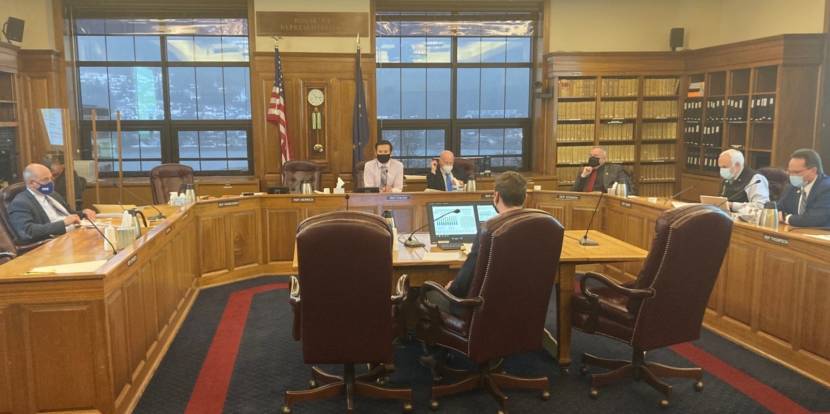
Alaska’s state government has more money flowing into it than it’s had in years. High oil prices, permanent fund growth and federal relief have allowed Gov. Mike Dunleavy to propose a budget that does not include large cuts or draw from savings.
But as lawmakers begin their work on the budget, some are raising concerns about how sustainable the governor’s plan is, and that could have big implications on the size of permanent fund dividends.
Dunleavy’s budget proposal depends on oil prices staying higher than they have in recent years. In his State of the State address, Dunleavy said the state shouldn’t count on this continuing.
“As Alaskans, we know the price of oil is volatile,” he said. “In just the past two years we’ve seen prices go from negative to nearly $90 per barrel. We know better than to take current prices for granted, and we must continue to hold the line on state spending without sacrificing core services, and that includes the PFD.”
Dunleavy has proposed a 50-50 PFD — that’s a change to the PFD formula that would pay dividends that are half of the annual amount the legislature draws from the Permanent Fund. This year, that would be more than $2,500.
He’s also proposed paying another $1,200 to make up the difference between the dividend he proposed last year and the one that got paid out.
The 50-50 PFD would be larger than what Alaskans have gotten in recent years. But it’s smaller than what Alaskans would receive under the formula that’s currently in state law — about $4,000. Critics of the current formula point to how much money that would spend down in the permanent fund’s earnings reserves.
Dunleavy’s administration has said the state can have balanced budgets in the long run and still pay the PFDs he’s proposed.
It could also help legislators campaigning for re-election. But some legislative leaders are not rushing to embrace the plan.
Rep. Bryce Edgmon said in a recent House Finance Committee meeting that it’s not realistic to pay large dividends and expect balanced budgets. He’s a Dillingham independent who caucuses with the mostly Democratic House majority.
“I’m a little uncomfortable when I hear the statement that, oh, in a few years, the governor’s 50-50 works out,” he said. “Well, to me that’s not complete. There’s so many other factors that we need to talk about before we can get to that statement.”
The Legislature has struggled to agree on changes to the dividend formula for six years.
Edgmon said this year’s dividend will lead to political pressure for the future.
“And that creates expectations that we need to grapple with in ensuing years, depending on whatever we do with the permanent fund dividend,” he said. “And I want to point that out, because that’ s what drives what happens in this building. And it has driven what’s happened in this building for some time now.”
One concern about setting dividends this year is that hundreds of millions of dollars in federal aid won’t be around in the future. Nonpartisan budget analysts have said that without the federal relief, Dunleavy’s proposed budget would have a $348 million deficit. And the budget also relies on more than $100 million in other forms of federal aid that are limited to the next few years.
Nome Democratic Rep. Neal Foster said he wants to consider the effect on budgets beyond next year. Citing Dunleavy’s proposed increases to public safety spending, Foster said the state shouldn’t count on the federal relief to pay for services that would continue well beyond the next budget.
“So I think we’re going to put a lot of emphasis on trying to balance the budget without those funds,” he said.
Foster co-chairs the House Finance Committee, which works on the budget. He noted that the Dunleavy’s administration’s 10-year-budget plan includes deficits in some future years.
“We want to create a budget that’s hopefully going to be more structurally sound, so that we’re not seeing those same deficits and at least minimize those as much as possible,” Foster said.
Another concern is that, outside of the permanent fund, the state has less in savings than at any point in more than a decade. That’s a major potential problem for a state government that relies on investments and oil, which are more volatile sources for its budget than other states do. So legislators are considering saving for the future.
Sitka Republican Sen. Bert Stedman said the extra money won’t last forever — and may not last beyond this year.
“So we need to be careful that we don’t get too euphoric at $80 per barrel and end up making our position worse in a couple years,” said Stedman, co-chair of the Senate Finance Committee.
Stedman said the Legislature must look beyond the next budget and the upcoming election.
There’s another factor that Dunleavy’s long term plan relies on: reductions in the state budget that the governor has not yet made clear.
The Legislature hasn’t settled on a PFD amount until toward the end of the session in recent years. And with the various pressures on the state budget in the long term, that process may play out again this year.
Andrew Kitchenman is the state government and politics reporter for Alaska Public Media and KTOO in Juneau. Reach him at akitchenman@alaskapublic.org.




